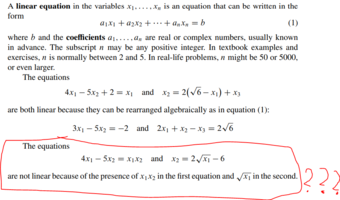Nemanjavuk69
Junior Member
- Joined
- Mar 23, 2022
- Messages
- 67
I am studying Linear Equations and need help understanding WHY the equation I have put a red square around IS NOT linear. I have a hard time figuring out when something is linear and when it is not.
I am using the book (linear algebra and its applications sixth global edition).
I understand that the first equation is linear, since we can write it as [imath]a_1x_1+a_2x_2+a_3x_3=b[/imath]
However, why is that not possible with the second equation? Why can't we just do this [math]x_2=2\sqrt{x_1}-6 <=> 6=2\sqrt{x_1}-x_2[/math]. so that way we can have all our variables on one side and the coefficient on the other side. Is the second equation not linear BECAUSE [math]4x_1-5x_2=x_1x_2[/math] consists only of variables? If so, why does the author not just write that instead of saying "and [imath]\sqrt{x_1}[/imath] in the second" hinting that there is something wrong with equation 2.2 also?

I am using the book (linear algebra and its applications sixth global edition).
I understand that the first equation is linear, since we can write it as [imath]a_1x_1+a_2x_2+a_3x_3=b[/imath]
However, why is that not possible with the second equation? Why can't we just do this [math]x_2=2\sqrt{x_1}-6 <=> 6=2\sqrt{x_1}-x_2[/math]. so that way we can have all our variables on one side and the coefficient on the other side. Is the second equation not linear BECAUSE [math]4x_1-5x_2=x_1x_2[/math] consists only of variables? If so, why does the author not just write that instead of saying "and [imath]\sqrt{x_1}[/imath] in the second" hinting that there is something wrong with equation 2.2 also?

